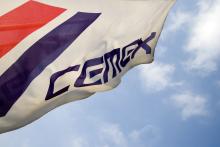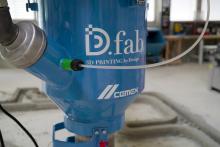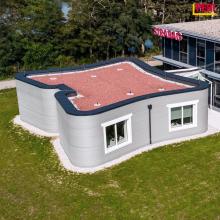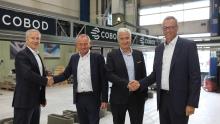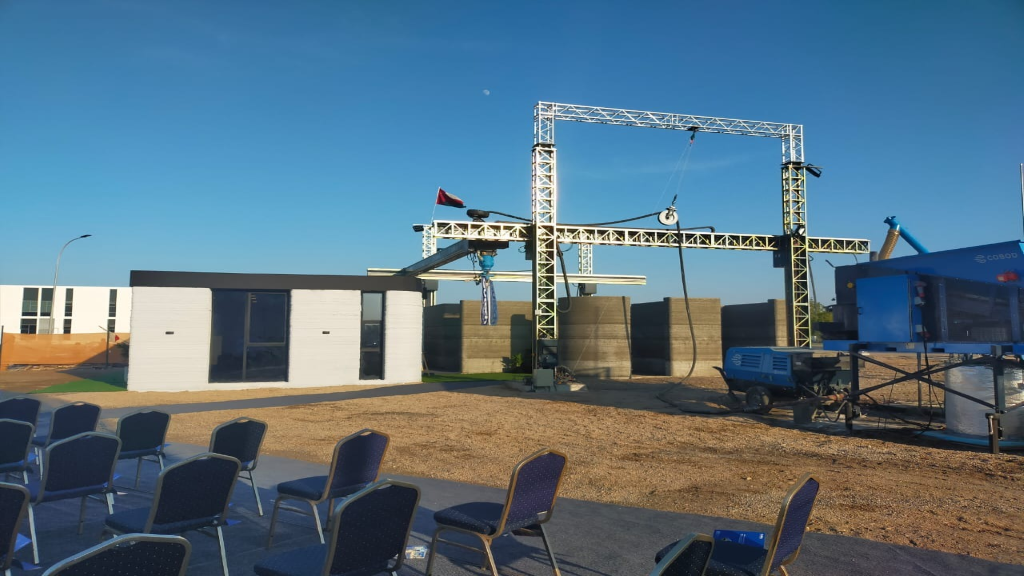
The event was marked by the presence of His Excellency Sultan Al-Habsi, Minister of Finance of Oman together with more than 200 guests including several ministers and VIPs of Oman, who attended the event in Muscat, the capital of Oman.
The house consists of 190m2 and is typical for a social housing unit in Oman. It has 3 bedrooms, three bathrooms, a living room, kitchen, and guest reception area. The house was printed in two stages. While the materials recipe was adjusted and training of the Omani crew took place during the printing of the first part of the house, the second part of the house was done by the Omani crew on their own and took on;y five days to complete. The project partners say this is a sign of fast learning and productivity improvements occurring in 3D printed projects.
Dr. Hussain, acting rector of GUtech, said: “Today’s display of the first 3D printed building is perhaps the first step in the 1,000-mile journey. A step that will not be success without the support of all parties involved. In this regard, I sincerely thank all the local and international parties who contribute to supporting the centre and the University. We hope that this center will play its part in supporting Oman’s efforts to achieve Oman’s Vision 2040.”
While the Middle East have seen numerous 3D printed buildings, the partners say the 190m2 building in Oman is the first to be printed with a real concrete instead of the traditional dry mix mortars used in most other 3D printed buildings. To make the concrete 3D printable, GUtech applied the D.fab solution developed by Denmark-based COBOD and CEMEX in cooperation where the concrete can have particle sizes up to 10mm (1/3 inch) and is made from locally available cement, sand, and gravel.
CEMEX and COBOD announced the D.fab solution in December in connection with the first 3D printed building in Angola. The D.fab solution was also used in Angola with the result that the cost of the concrete materials was less than US$1,000 for the 5em2 house.
On that occasion Juan Romero, executive VP sustainability, commercial, and operations development at CEMEX, said: “The introduction of this revolutionary 3D printing system is a testament to our customer-centric mindset and relentless focus on continuous innovation and improvement. Working together with COBOD, we have developed an experience for customers that is superior to anything that has been provided in the past."
In the Oman project more than 99.5% of the materials used were local, with less than 0.5% coming from Europe in the form of the D.fab additives. In Oman the cost of materials for 3D printing of the walls of the 190m2 house was less than €1,600. According to COBOD, if a printable dry mix mortar had been used the cost of the materials would be more than 20,000 Euro, and it was such significant cost reductions which COBOD and CEMEX was aiming for with their cooperation.
Commenting on this milestone for the widespread adoption of the 3D construction printing method, Henrik Lund-Nielsen, founder & general manager of COBOD International stated: “While we have been happy to help various cement and concrete manufacturers develop dry mix 3D printable mortars, we have also insisted on that a solution for making real concrete made from local available materials would be needed for mass application of our technology.
"We are more than pleased that CEMEX took on the challenge, and proud that we in cooperation could develop the new solution, which GUtech has now applied to the first building in Oman. With the low cost for the printed materials, on top of the savings from not needing formwork and the minimal crew needed to operate our printers, our disruptive technology is now more competitive than ever before in Oman and everywhere in the world."

